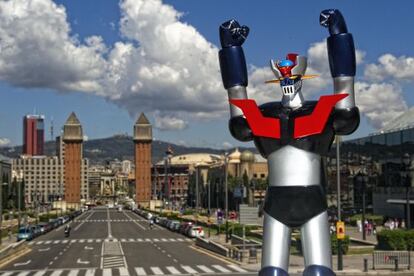The robots rise in Barcelona
The city’s comic convention pays tribute to androids in cartoons, film and books


When state broadcaster Televisión Española (TVE) first started showing the Japanese anime series Mazinger Z in 1978, Spaniards were dazzled by its freshness and exoticism at a time when program choice was limited. Over the years this cartoon series — about a giant robot constructed by Professor Kabuto and passed on to his grandson Kouji before his death — has generated merchandise, stickers, magazines and comics and has remained in the subconscious of a generation, even though only 32 of the 92 episodes made were ever shown in Spain. TVE considered it “too Japanese and too violent.”
The series’ creator, Go Nagai, is one of the big names attending this year’s Salón Internacional del Cómic de Barcelona (Barcelona International Comic Convention), which is running at the Fira Barcelona until Sunday. The exhibition Robots en su tinta (Robots in their element) offers a survey of androids in comics, literature and film and also includes real human-like machines able to interact with visitors.
Jordi Ojeda, a professor at the Polytechnic University of Catalonia and a comic lover, has brought together over 150 original comics to show how the art form has drawn and imagined these manmade beings for the exhibition. Among them are Marvel Comics superhero Iron Man, crammed inside a suit of armor; the agile, amoral and underground RanXerox, by Tanino Liberatore, who will be dropping in; Osamu Tezuka’s Astroboy; and José Sanchís’ Robin Robot. For the first time, visitors will also be able to see the robots drawn by recent National Comic Prize winner Santiago Valenzuela for Las aventuras del capitán Torrezno 8, which he has handed over to the exhibition.
Robots en su tinta will also feature workshops, the 15th National Robot Competition and five androids “in the flesh,” which include the ABB Group’s industrial robot, used in the car industry, which will paint and sign pictures for visitors; Darwin, a Korean prototype that can walk and play soccer; and REEM, which has been dubbed the best robot in the world in France. Developed by Pal Robotics, this female robot can be used at fairs, hotels and shopping malls to provide information, as well as help with housework. She also talks, and isn’t ashamed to say she wants to be famous.
The robots will be accompanied by a host of other exhibitions, concerts, encounters with authors, workshops and movie marathons. A Tribute to Moebius will feature original work by the French comic artist also known as Jean Giraud, who died in March, as well as pieces by Spanish artists paying homage to the great man. There will be a look back over the origins and evolution of Spiderman, created 50 years ago by Stan Lee and Steve Ditko, and a retrospective of Little Nemo, featuring original work from the classic comic strip created by Winsor McCay (1869-1934).
Another strand examines DC Comics’ 2011 New 52 relaunch of all its major characters — Batman, Superman, Wonder Woman, et al — for the 21st century, while there will be individual exhibitions for Jordi Longarón, one of the first Spanish comic authors to achieve international success, and Paco Roca, creator of the prize-winning, recently filmed Arrugas, as well as the poster for this year’s show.
China is this year’s guest country and 200 square meters of floor space will be given over to revealing the history of Chinese comics, which, despite selling millions of copies in their domestic market, are largely unknown in the west.
Other invited guests include Milo Manara (Borgia), David Lloyd (V for Vendetta), Gilbert Shelton (The Fabulous Furry Freak Brothers), Craig Thompson (Blankets) and Enrique Breccia (El Eternauta), among others.
The show features 150 exhibitors — 20 percent more than last year — and even though public funding for the event has dropped 10 percent, it has maintained its 700,000-euro budget thanks to private sponsorship, above all from videogame and electronics firms keen to present their new wares.
The comic book sector is the area of the publishing industry that is most rapidly embracing the digital world, with 94 percent of comic publishers already having a digital arm. One symptom of the change is that the Spanish Federation of Editors’ Associations says that the comics sector was the only area of the publishing industry to increase its sales in 2010, bringing in 85 million euros (32.4 percent more than in 2009). However, the Education, Culture and Sports Ministry says its figures show that in the same year it applied for a lot fewer permits for ISBN numbers to publish new titles — 1,891, 35.2 percent less than in 2009.
One statistic this year’s show may find hard to beat is the 100,000-visitor mark it has achieved in previous years. However, the fact that the entrance price remains at six euros — the same as the last seven years — and that those born in 1982, the year the event began, can get in free, will certainly help matters.
Tu suscripción se está usando en otro dispositivo
¿Quieres añadir otro usuario a tu suscripción?
Si continúas leyendo en este dispositivo, no se podrá leer en el otro.
FlechaTu suscripción se está usando en otro dispositivo y solo puedes acceder a EL PAÍS desde un dispositivo a la vez.
Si quieres compartir tu cuenta, cambia tu suscripción a la modalidad Premium, así podrás añadir otro usuario. Cada uno accederá con su propia cuenta de email, lo que os permitirá personalizar vuestra experiencia en EL PAÍS.
¿Tienes una suscripción de empresa? Accede aquí para contratar más cuentas.
En el caso de no saber quién está usando tu cuenta, te recomendamos cambiar tu contraseña aquí.
Si decides continuar compartiendo tu cuenta, este mensaje se mostrará en tu dispositivo y en el de la otra persona que está usando tu cuenta de forma indefinida, afectando a tu experiencia de lectura. Puedes consultar aquí los términos y condiciones de la suscripción digital.








































